
TNU Journal of Science and Technology
229(06): 57 - 64
http://jst.tnu.edu.vn 57 Email: jst@tnu.edu.vn
IDEMPOTENT TRIANGULAR MATRICES OVER COMMUTATIVE SEMIRINGS
Ha Chi Cong *
University of Finance and Accountancy
ARTICLE INFO
ABSTRACT
Received:
11/10/2023
The structure of idempotent triangular matrices with elements on the
main diagonal being 0 or 1 over a commutative ring has been fully
described by Xin Hou (2021). These results have also been
generalized by Stephen E. Wright (2022) when studying the structure
of idempotent triangular matrices over the general rings. Furthermore,
Stephen E. Wright (2022) has provided formulas for calculating the
number of matrices of this type within finite rings. In this paper, we
investigate the characteristic properties of idempotent triangular
matrices over commutative semirings and describe the structure of
such matrices in cases where the entries on their main diagonal are
pairwise orthogonal idempotent elements. Simultaneously, we
proceed to compute the number of idempotent triangular matrices
with entries on the main diagonal being 0 or 1 when the
corresponding semirings are commutative, additively idempotent, and
have a finite number of elements.
Revised:
25/3//2024
Published:
25/3//2024
KEYWORDS
Ring
Semiring
Triangular matrix
Idempotent matrix
The main diagonal
MA TRẬN TAM GIÁC LŨY ĐẲNG TRÊN NỬA VÀNH GIAO HOÁN
Hà Chí Công
Trường Đại học Tài chính – Kế toán
THÔNG TIN BÀI BÁO
TÓM TẮT
Ngày nhận bài:
11/10/2023
Cấu trúc của các ma trận tam giác lũy đẳng có các phần tử trên đường
chéo chính là 0 hoặc 1 trên vành giao hoán đã được Xin Hou (2021) mô
tả đầy đủ. Các kết quả này cũng đã được tổng quát hóa bởi Stephen E.
Wright (2022) khi nghiên cứu cấu trúc của các ma trận tam giác lũy
đẳng trên vành tổng quát. Hơn nữa, Stephen E. Wright (2022) đã cung
cấp các công thức tính số ma trận dạng này đối với các vành hữu hạn.
Trong bài báo này, chúng tôi khảo sát các tính chất đặc trưng của các
ma trận tam giác lũy đẳng trên nửa vành giao hoán và mô tả cấu trúc
của các ma trận dạng này trong trường hợp các phần tử trên đường chéo
chính của chúng là các phần tử lũy đẳng trực giao từng đôi một. Đồng
thời chúng tôi tiến hành tính toán số các ma trận tam giác lũy đẳng có
các phần tử trên đường chéo chính là 0 hoặc 1 khi các nửa vành tương
ứng là giao hoán, lũy đẳng cộng và có hữu hạn phần tử.
Ngày hoàn thiện:
25/3//2024
Ngày đăng:
25/3//2024
TỪ KHÓA
Vành
Nửa vành
Ma trận tam giác
Ma trận lũy đẳng
Đường chéo chính
DOI: https://doi.org/10.34238/tnu-jst.8971
Email: hachicong@tckt.edu.vn

TNU Journal of Science and Technology
229(06): 57 - 64
http://jst.tnu.edu.vn 58 Email: jst@tnu.edu.vn
1. Introduction
Studying the structure of idempotent triangular matrices over rings plays a crucial role in
algebra, the structure of idempotent triangular matrices over rings has been fully described in [1]
and [2]. In [1], Xin Hou provided a formula for calculating the number of idempotent triangular
matrices over a commutative ring with elements 0 or 1 on the main diagonal. The results of Xin
Hou were generalized by Stephen E. Wright (see [2]) for idempotent triangular matrices over
both commutative and noncommutative rings.
In recent times, along with the strong development of the semiring theory [3], the study of the
structure of idempotent matrices on specific classes of semirings has also gained attention, for
example, the semiring of non-negative real numbers, boolean algebra, chain semiring, tropical
semiring and other semirings (see [4] - [8]). However, there are not many results on the structure
of idempotent triangular matrices over general semirings. In this article, we aim to describe the
structure of idempotent triangular matrices on commutative semirings, we will investigate
idempotent triangular matrices with elements on the main diagonal being 0 or 1, and calculating
the number of such matrices on finite semirings that are commutative and additively idempotent.
2. Preliminaries
A Semiring [3] is a set R equipped two binary operations addition
and multiplication
.
such that
,R
is a commutative monoid with identity element 0,
,.R
is a monoid with
identity element 1, multiplication distributes on both sides with addition and
0. .0 0,s s s R
.
A semiring R is commutative if
. . , ,a b b a a b R
; R is said to be zerosumfree if
0 0, ,a b a b a b R
; R is additively idempotent if
,a a a a R
. Notice that if R is
additively idempotent then it is zerosumfree. Indeed, if
,x y R
such that
0xy
then
00x x x x y x y
and therefore
0y
. Let R be a semiring that is commutative and
additively idempotent, we equip R with a binary relation
""
(see [7]) as follows: Let
,.r t R
If
r t t
then we write
rt
. Then,
""
is a partial ordering. Note that if
ab
then we can
write
ba
for all
,a b R
, if
ab
and
ab
then we can write
ab
or
ba
. It is easy to
see that
,a b a R
if and only if
0b
. Let R be a semiring, an element
aR
is additively
invertible if there exists an element
bR
such that
0ab
, the element b is denoted by
a
.
The set of all additively invertible elements in R is denoted by V(R).
In this paper, the set of all
mn
matrices over semiring
R
is denoted by
mn
MR
and
n
MR
if
mn
; the
,ij
entry of a matrix
m n m n
A M R
is denoted by
ij
a
or
,ij
a
. Recall [8]
that a matrix
n
A M R
is called invertible if there exists a matrix
n
B M R
such that
..
n
A B B A I
, the matrix B is called inverse of A and denoted by
1
A
. We denote by
n
GL R
the
set of all invertible matrices in
n
MR
. A matrix
n
A M R
is called idempotent if
2
AA
. A
matrix
ij n
B b M R
is called (upper) triangular matrix if
0, 1
ij
b j i n
, the set of all
triangular matrices in
n
MR
is denoted by
n
TM R
; let
,mn
A B M R
, if there exist
,
mn
P GL R Q GL R
such that
A PBQ
then we say that A and B are equivalent; for any
matrix
ij n
A a M R
, we denote by
11 12
1 11 2
21 22
; ;...; n
aa
A a A A A
aa
the principal
submatrices of A.
Proposition 2.1 ([8, Lemma 2.1]). Let R be a semiring, if
s V R
then

TNU Journal of Science and Technology
229(06): 57 - 64
http://jst.tnu.edu.vn 59 Email: jst@tnu.edu.vn
,,rs sr V R r R
.
Proposition 2.2 ([8, Lemma 2.2]). If
ij n
A a M R
is invertible on the commutative
semiring R then
,
ik jk ki kj
a a a a V R
for all
, , 1,...,i j k n
with
ij
.
3. Main results
In this section, we establish several characteristic properties of idempotent triangular matrices
over semirings which are commutative and additively idempotent, and calculate the number of
such matrices in case of finite semirings.
Proposition 3.1. Let R be a semiring,
,,
k p k p
A M R D M R B M R
. If the block
matrix
0
AB
D
is idempotent then A and D are also idempotent matrices.
Proof. We have
22
2
0 0 0 0
A B A B A B A AB BD
D D D D
, since
0
AB
D
is
idempotent, hence,
2
AA
and
2
DD
. So, A and D are idempotent matrices.
From Proposition 3.1, we easily obtain the following results:
Corollary 3.2. Let R be a commutative semiring and
n
A TM R
. Then
A
is idempotent if
and only if all principal submatrices of A are idempotent.
Remark 3.3. If
ij n
A a TM R
is idempotent then
2, 1,...,
ii ii
a a i n
.
Proposition 3.4. Let R be a commutative semiring and
ij n
A a TM R
is an idempotent
matrix. If
0, 1,...,
ii
a i n
then
0A
.
Theorem 3.5. Let R be a commutative semiring. Then, the following statements are
equivalent:
i) For every idempotent triangular matrix
n
A TM R
whose main diagonal has k entries
equal to 1, and the rest equal to 0 (
0kn
), there exist invertible matrices
,n
U V GL R
such
that
0
0
k
I
VAU B
, where all entries of the main diagonal of matrix
B
are equal to 0;
ii) R is a ring.
Proof.
:i ii
For any
aR
, the matrix
1
00
a
A
satisfies
2
AA
. Hence,
A
is
idempotent. Thus, there exist invertible matrices
2
,U V GL R
such that
10
00
VAU
. This
implies that
11
10 .
00
A V U
Suppose that
11
,
b c s t
UV
d e u v
, we have
1
00
a sb sc
ub uc
, this follows that
1
sc a
sb
. Since the matrix
1bc
Ude
is invertible,
hence,
bc V R
(by Proposition 2.2). Therefore, there exists
qR
such that
0q bc
, this
follows that
0sq sbc sq c
(because
1sb
) , and so,
c V R
. By Proposition 2.1,
a sc V R
. Thus, R is a ring.

TNU Journal of Science and Technology
229(06): 57 - 64
http://jst.tnu.edu.vn 60 Email: jst@tnu.edu.vn
:ii i
Suppose that R is a ring and
ij n
A a TM R
is an idempotent matrix whose main
diagonal has k entries equal to 1, and the rest equal to 0 (
0kn
). Then, by using elementary
operations on matrix A as follows: If
1
ii
a
, multiply the entries in the i-th row by
li
a l i
and add to the l-th row; multiply the entries in the i-th column by
it
a t i
and add to the t-th
column. Afterward, rearrange the rows and columns of the resulting matrix to obtain a matrix
equivalent to A in the form
0
0
k
nk
I
B
, where all entries of the main diagonal of matrix
B
are
equal to 0.
Lemma 3.6. Let R be a commutative semiring, and
,4
ij n
A a TM R n
be an
idempotent matrix satisfying the condition
0
ii jj
aa
for all
, 1,2,...,i j n
with
ij
. Then,
0
ik kl lp
aaa
for all
, , , 1,...,i k l p n
with
i k l p
.
Proof. If
4n
then
12 11 12 12 22 12 11 22
a a a a a a a a
,
23 22 23 23 33 23 22 33
a a a a a a a a
,
34 33 34 34 44 34 33 44
a a a a a a a a
and
12 23 34 12 23 34 11 22 22 33 33 44 0a a a a a a a a a a a a
(because
0,
ii jj
a a i j
). Assume the Lemma holds for
4n k k
. For any matrix
1ij k
A a TM R
, A is idempotent, we rewrite the matrix A in the form
1, 1
0
k
kk
AB
Aa
or
11
0k
aC
AD
. By Proposition 3.1,
,
k k k
A D TM R
are idempotent matrices. Put
lm mq qp
r a a a
with
11l m q p k
, we have
If
1pk
then
0
lm mq qp
r a a a
(because
,,
lm mq qp
a a a
are entries of
kk
A TM R
).
If
1l
then
0
lm mq qp
r a a a
(because
,,
lm mq qp
a a a
are entries of
kk
D TM R
).
If
1l
and
1pk
then
1 , 1m mq q k
r a a a
. We have
1
1 1 11 1
2
m
m m mm h hm
h
a a a a a a
,
, 1 , 1 1, 1 , 1
1
k
q k q k qq k k qt t k
tq
a a a a a a
. This follows that
1 , 1 11 1, 1 11 1 , 1
1
k
m mq q k mm qq k k mm m mq qt t k
tq
r a a a a a a a a a a a a a
11
1, 1 1 , 1 1 , 1
2 2 1
.
m m k
qq k k h hm mq q k h hm mq qt t k
h h t q
a a a a a a a a a a a
Since
0,
ii jj
a a i j
and
1 , 1 0
m mq qt t k
a a a a
,
1 , 1 0
h hm mq q k
a a a a
,
1 , 1 0
h hm mq qt t k
a a a a a
for all
, , , 2,...,h m q t k
with
h m q t
, hence,
0r
.
Lemma 3.7. Let R be a commutative semiring, and
,3
ij n
A a TM R n
be an
idempotent matrix satisfying the condition
0
ii jj
aa
for all
, 1,2,...,i j n
with
ij
. Then,
lm mk lm mm mk
a a a a a
for all
, , 1,...,l m k n
with
l m k
.
Proof. If
3n
then
12 11 12 12 22 12 11 22
a a a a a a a a
,
23 22 23 23 33 23 22 33
a a a a a a a a
and
12 23 12 23 11 22 22 33 12 22 23
a a a a a a a a a a a
(because
0,
ii jj
a a i j
). If
4n
then for

TNU Journal of Science and Technology
229(06): 57 - 64
http://jst.tnu.edu.vn 61 Email: jst@tnu.edu.vn
any
, , 1,...,l m k n
with
l m k
, we have
1
1
m
lm lm ll mm lt tm
tl
a a a a a a
and
1
1
k
mk mk mm kk ms sk
sm
a a a a a a
, this follows that
lm mk lm mk ll mm mm kk
a a a a a a a a
1 1 1 1
1 1 1 1
k m m k
ll mm lm ms sk mm kk lt tm mk lt tm ms sk
s m t l t l s m
a a a a a a a a a a a a a a
. By Lemma 3.6,
lm mk lm mk ll mm mm kk lm mm mk
a a a a a a a a a a a
(because
0
ll mm mm kk
a a a a
).
Theorem 3.8. Let R be a commutative semiring, and
ij n
A a TM R
be an idempotent
matrix satisfying the condition
0
ii jj
aa
for all
, 1,2,...,i j n
with
ij
. Then, A is described
by the following statements.
i) If
1n
then
11
Aa
with
2
11 11
aa
;
ii) If
2n
then
2, 1,2
ii ii
a a i
and
12 12 11 22
a a a a
;
iii) If
3n
then
2, 1,...,
ii ii
a a i n
and
1
1
,1
, 1 .
,1
ij ii jj
j
ij
ij ii jj il ll lj
li
a a a j i
a i j n
a a a a a a j i
Proof. The Theorem is deduced from Remark 3.3 and Lemma 3.7.
Consider now the structure of idempotent triangular matrices over semirings that are
commutative and additively idempotent.
Proposition 3.9. Let R be a finite semiring that is commutative and additively idempotent
with partial ordering
""
,
ij n
A a TM R
be an idempotent matrix with
0,1 , 1,...,
ii
a i n
.
i) If
1n
then
11
Aa
where
11 0a
or
11 1a
.
ii) If
1n
then entries
1
ij
a i j n
are chosen as follows: If
0
ii jj
aa
then
1
1
0, 1
,1
j
ij
il lj
li
ji
aa a j i
; if
1
ii jj
aa
then
,1
,1
ij
t j i
am j i
, where t is arbitrarily chosen from
R and
mR
such that
1
1
j
il lj
li
m a a
.
Proof. In the case of
1n
, it is obviously. If
1n
, then for any
, 1,...,i j n
with
ij
. If
1ji
then
0, 0
, 1
ii jj
ij ii ij ij jj ij ii jj
ij ii jj
aa
a a a a a a a a a a a
. Thus, if
1
ii jj
aa
, the
corresponding entry
ij
a
is arbitrarily chosen from R. If
1ji
the
1
1
1
1
1
1
, 0
, 1
j
il lj ii jj
j
li
ij ij ii jj il lj j
li
ij il lj ii jj
li
a a a a
a a a a a a
a a a a a
.


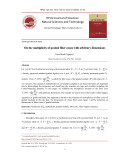
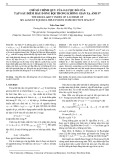
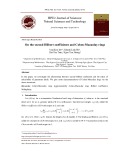
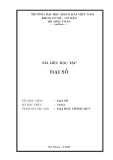

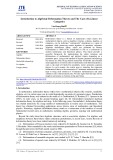
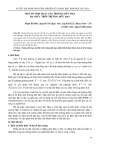
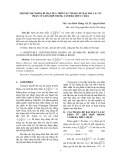
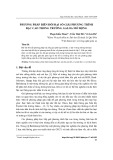










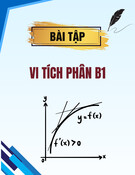



![Quyển ghi Xác suất và Thống kê [chuẩn nhất]](https://cdn.tailieu.vn/images/document/thumbnail/2025/20251030/anh26012006/135x160/68811762164229.jpg)
